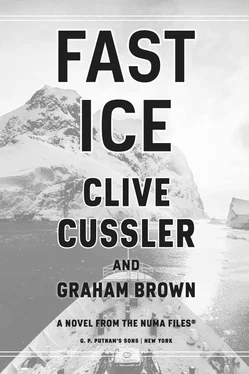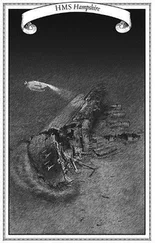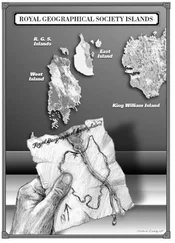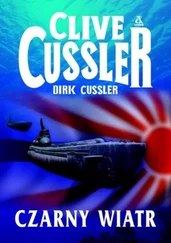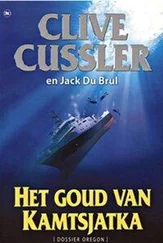“Tell me about the Fast Ice plan again,” he asked Kurt. “Not the part with the iceberg. The second part. Drafting Jurgenson and the search for the ‘magic liquid’ he found.”
“They were going to release the algae into the bay and freeze the Russians in their port,” Kurt said.
“That’s what I thought.” He held up the tablet for Kurt. “Take a look at Fimbul Bay. What do you see?”
Kurt glanced over quickly before turning his attention back to the task at hand. “I see a deep bay with a hook of sea ice where it reaches the ocean. What am I missing?”
“Nothing,” Joe said. “That’s what I see. But based on the contours alone, I can tell it’s a stagnant backwater without much circulation. Now, what do you think happens if Ryland starts pumping that algae into the bay?”
“A quick freeze,” Kurt said. “The fast ice would grow out from the edges toward the middle, sealing the bay shut, just like the Nazis intended when they came up with the plan to begin with.”
Joe nodded. “And the rest of the algae would be trapped in a pool behind it. Which is part of the reason the normal ice age process takes thousands of years. Because the algae tends to trap itself, only leaking out into the ocean in very small quantities over a period of centuries.”
“An issue Ryland is trying to circumvent by filling tankers with the stuff and dumping it on the other side of the ocean,” Kurt replied.
“And if he’s smart enough to do that,” Joe said, “he’s smart enough to do something similar down here. He’s not going to be content with letting the algae trickle into the bay and inch its way to the ocean fifty miles beyond.”
“Could he have built a physical pipeline from the end of the ice tunnel out to the bay?” Kurt asked.
“That depends,” Joe said. “How large would you say the conduit is?”
“From what I saw in the cavern, the outgoing pipe was about four feet in diameter.”
“That would match the estimate Hiram’s computer came up with for the underground tunnel,” Joe said. “How long do you think it would take to build a fifty-mile pipeline four feet in diameter?”
Kurt continued to guide the craft while doing some mental calculations. “It took about three years to build the Alaska Pipeline,” he said. “It’s about eight hundred miles long, so that’s about twenty to thirty miles a month. And there were fifty thousand people working on it.”
“And it was aboveground,” Joe said.
“Good point,” Kurt said. “Even if Ryland had a thousand people for the job, which I doubt, he couldn’t possibly build more than a couple miles’ pipe per month in an ice-filled bay. Not even with multiple submarines.”
“It’s slow work,” Joe said. “I’ve done some of it in the Gulf of Mexico and we had nice weather.”
Kurt understood what Joe was getting at. “Ryland has a ship down there.”
“That would be my guess,” Joe said. “A tanker. Or several of them.”
Kurt tightened his grip on the tiller and leaned back. He repositioned the sail to keep the snow racer running in a broad reach. It whipped across the open field of white, picking up even more speed. A tanker meant the algae was being stored and contained. It meant the genie was still in the bottle and he and Joe had the chance to keep it there.
“You’re a genius,” he told Joe. “Now, get on the satellite phone and give Rudi an update. Tell him to look for a ship in the bay and let him know if we stop the ship, we stop Ryland’s plan.”
57
Joe’s satellite call reached the NUMA tactical room in Washington, where Rudi had gathered with Hiram and Lee Garland.
As Joe’s voice faded in and out, it became impossible to parse the words from the distortion and gaps in the signal. Rudi turned to the satellite wrangler. “Why is it so broken up?”
“The storm is wreaking havoc with communications,” Garland said. “I’m amazed the call came through as well as it did.”
“We need to hear what Joe’s saying,” Rudi replied. “Can you clear it up?”
Garland shook his head. “We can boost our signal and get a message through to them, but the handheld unit isn’t going to suddenly double in transmission power and be able to cut through the storm. I suggest we tell them to use the datalink. It’s like texting. It uses far less bandwidth than voice communications and will be more likely to get through.”
“Do it,” Rudi said.
Garland tapped out a message explaining the difficulty they were having and the procedure for using the datalink. A minute went by before they got a response. The text appeared on a big screen at the front of the room. It read like a message from Tarzan.
Pumps still in operation. Pipeline intact. Both out of reach. Ryland’s plan unaffected.
Rudi read the message stoically.
“Two strikes,” Hiram said from beside him, “but at least we’re still at bat.”
A second message followed.
Be advised saboteurs ready on Liang’s ships. Must take by surprise or will scuttle.
Rudi nodded to Garland. “Signal them ‘Understood.’ And get the saboteur information over to the Navy, they’re tracking down Liang’s ships.”
“Are they close?” Yaeger asked.
“Last I heard,” Rudi said. “As I understand it, SEAL teams are ready to pounce on three of the tankers, with British SAS units taking the other two. The plan is to hit them simultaneously.”
As Garland typed the reply, a third message from Joe arrived.
Paul and Gamay still at pumping station. Paul injured but stable. Suggest evac ASAP. We are heading to the coast. Ryland must have ship. Large ship. Find it in Fimbul Bay. We will disable. Somehow.
For a second Rudi was baffled. “A ship?” he turned to Hiram. “Could they be right?”
“I don’t see how,” Hiram said. “We had multiple satellite passes over that bay before the weather closed in. We would have seen a heat plume if there was a ship operating in the area. Especially a large one.”
Rudi looked at Garland. “What do you think?”
Garland offered a quick shake of the head. “The infrared detectors on our satellites are incredibly sensitive. A large ship operating in a cold ocean is the easiest thing in the world to spot. Don’t see how we could have missed a vessel operating in that area.”
“What if it was a submarine?” Rudi asked.
Hiram’s eyebrows went up. “That’s a possibility.”
Rudi turned back to Garland. “Tell them we’ve seen nothing to indicate a ship but we’re considering the possibility of a submarine.”
Garland sent the message out and everyone waited. The return text was adamant.
Not a submarine. Has to be larger. Look for a supertanker or LNG or several. Ryland needs to get algae out of bay in large volume.
Rudi now understood. He looked to Garland once more. “Can we run another pass?”
“It won’t do any good,” Garland said. “The area is under a thick layer of cloud. We can’t see through it on a visible wavelength and infrared will be scattered and absorbed as well.”
Rudi glanced at the weather screen, where the storm appeared as a swirling mass of clouds hiding everything underneath it in the fog of war.
“What else do we have?” Rudi asked. “There has to be something.”
“Radar might do it,” Garland said. “We have a long-wavelength system designed to give us land contours, but the image isn’t going to look like a photograph. More like an X-ray.”
“Will it be able to distinguish a ship from the surroundings?”
Garland nodded. “We should get a much stronger reflection off a steel-hulled vessel than from ice and snow or water.”
Rudi was satisfied. “Get that satellite in place as fast as possible. We need to see through those clouds.”
Читать дальше
